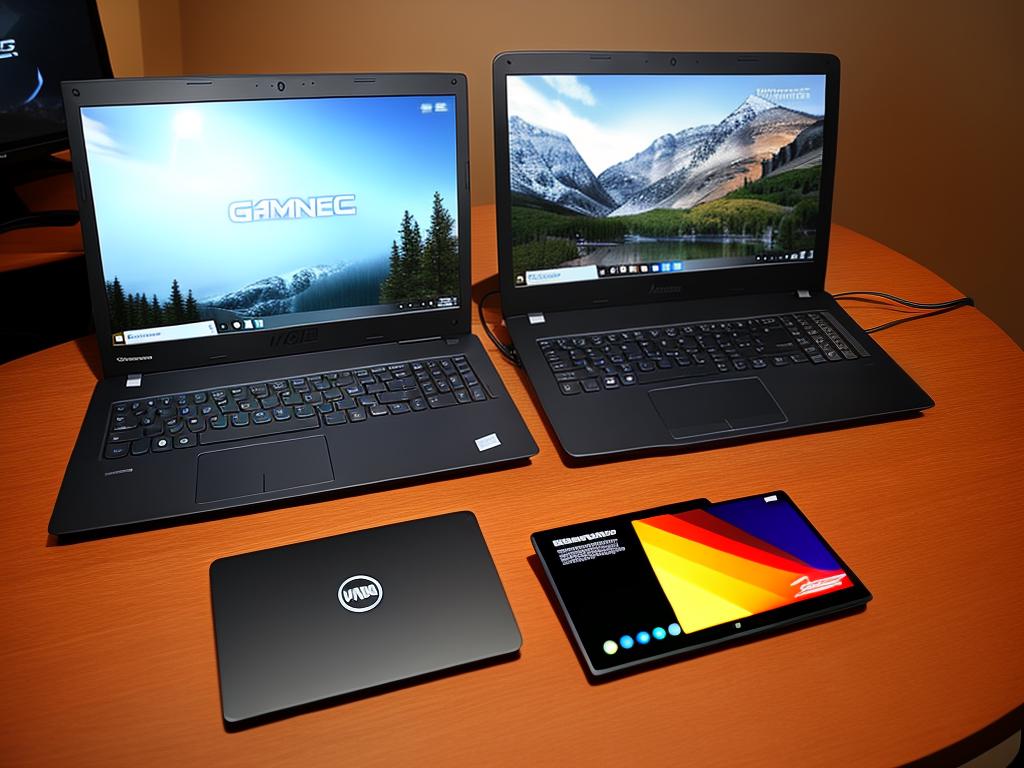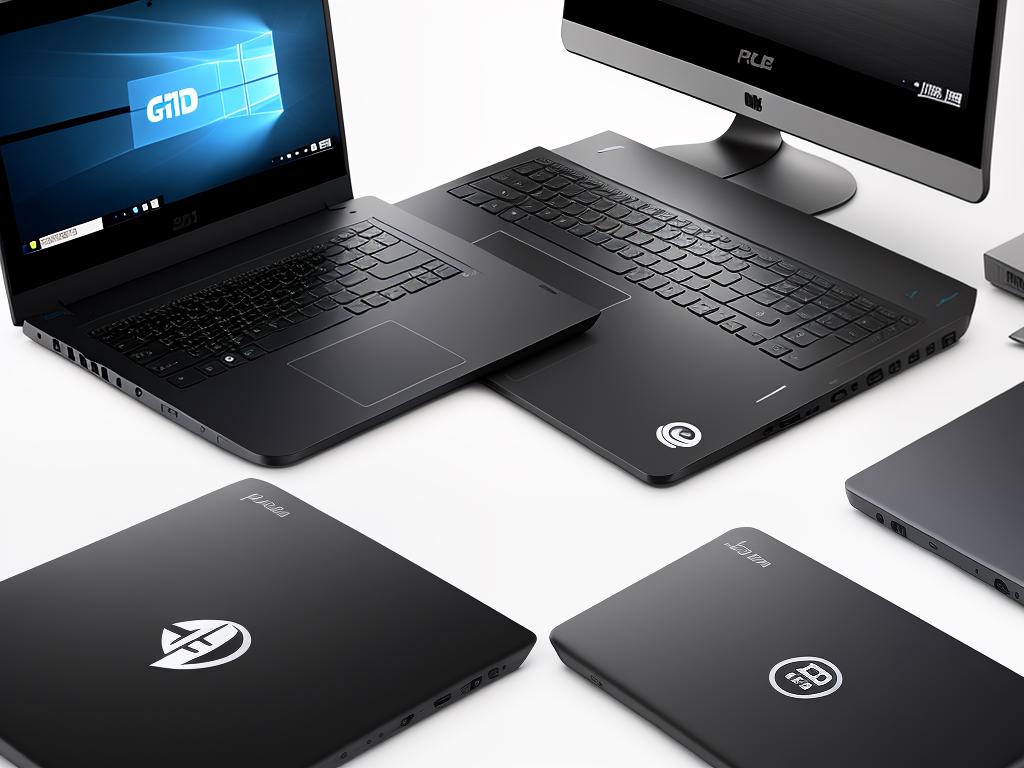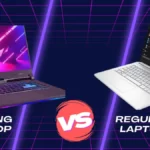In today’s ever-evolving world of technology, consumers are often bombarded with an array of choices, especially when it comes to laptops. Among these, two types stand out: gaming laptops and regular laptops. Distinguishing one from the other can be perplexing to many. However, understanding the key differences between them is crucial when deciding which one to purchase. This discussion aims to elucidate these dissimilarities, focusing on hardware specifications, software and performance, design and aesthetic variations, as well as pricing and value. By delving into these nuanced facets, buyers can make informed decisions suiting their needs and preferences, be it gaming, professional use, or personal leisure.
Table of Contents
Hardware Differences
Processing Power: Gaming laptops vs Regular laptops
Gaming laptops often pack significantly more processing power than their regular counterparts, to accommodate the demands of modern, CPU-intensive video games. This power is often delivered by multi-core processors which are well-equipped to multitask efficiently, closely mirroring the simultaneous processing demands of a running video game. Regular laptops, on the other hand, are typically equipped with less powerful, dual-core or quad-core CPUs which are more than adequate for tasks such as browsing the Web or working on spreadsheets, but may be hard-pressed to run resource-hungry games smoothly.
Graphics Cards: Where visuals come UHD or just HD
A marked hardware difference between gaming and regular laptops is the presence of a dedicated graphics card, or GPU. A gaming laptop generally employs a powerful GPU to render the intricate visuals and special effects of most video games. This results in a crisper, more fluid visual performance, particularly with respect to fast-paced, action-heavy games.
Conversely, regular laptops often make do with integrated graphics, which share memory with the CPU and are adequate for tasks like office work and media streaming, but can falter or lag when tasked with gaming.
Cooling Systems: Keeping the heat in check
To prevent overheating from the high-performance components running full-tilt, gaming laptops typically have robust, advanced cooling systems. These systems may include multiple fans, heat sinks, and vents to dissipate the heat generated during intensive gaming sessions. Regular laptops, being less performance-oriented, do not require such sophisticated cooling mechanisms. Instead, they often rely on a single fan, or at most a couple of fans, to ward off occasional spikes in temperature.
Memory and Storage Options: Room for gameplay
With respect to memory, or RAM, gaming laptops pull ahead with greater capacities, typically starting from 16GB and going upwards. The generous allotment of RAM allows these computers to support the vast, open-world games that are popular today, along with maintaining fast, seamless performance during gameplay.
Regular laptops generally come with less RAM, with many configured with 4GB or 8GB. This is sufficient for typical tasks such as web browsing and document editing but may result in stuttering or lag during gaming.
Storage-wise, gaming laptops often provide a combination of hard disk drive (HDD) and solid state drive (SSD) for their storage needs to ensure speed and capacity. Regular laptops usually come with either an HDD or SSD, lacking the dual drive systems of gaming laptops.
In a Nutshell
There is a distinct difference between gaming laptops and regular laptops, primarily in terms of performance and hardware requirements. Gaming laptops are specifically engineered to cope with the high performance demands of modern video games. They have more robust hardware configurations than their regular counterparts. On the other hand, regular laptops are generally designed with versatility in mind, able to accommodate a broad spectrum of everyday tasks.

Software and Performance
Diving Deeper: Software and Performance
When we delve into the aspects of software and performance, the differences between gaming laptops and regular laptops solidify. Gaming laptops are bolstered to handle heavy duty graphics and fast-paced gameplay. This necessitates robust processing power, superior graphics units, and fast memory capabilities. Conversely, regular laptops are primed for everyday usage, which can include tasks such as web browsing, video streaming, and running office suite applications.
Real-time Performance: The Gaming Advantage
When it comes to real-time performance, gaming laptops outshine regular ones due to their gaming-optimized hardware and software. Gaming laptops usually come with powerful processors, higher RAM capacity, dedicated graphics cards, and higher-refresh-rate displays. These attributes allow these machines to run demanding games smoothly, offering users an enhanced gaming experience.
On the software side, gaming laptops are specifically designed with unique gaming modes. For instance, many have software that allows personalized keyboard lighting configurations for specific games and the option to activate high-performance mode for gaming, which allocates more resources towards gameplay.
Standard Laptop Software Features
Regular laptops are typically less focused on specialized, high-powered performance. Their software is designed to provide a balanced functionality suitable for a variety of uses. Instead of gaming modes or dedicated graphics, a regular laptop’s software is geared towards optimizing productivity applications, Internet browsing, and multimedia playback. They typically come with integrated graphics, which suffices for run-of-the-mill tasks but falls short for rendering high-quality game graphics.
However, it’s important to note that regular laptops still provide adequate performance for most computer users. While not designed for high-end gaming, these computers can still handle less-intensive games and run most regular-use software without issues.
Gaming Optimizations: A Deeper Dive
Gaming laptops come with extensive customization options that contribute to the overall gaming experience. These include overclocking utilities, which allow users to increase their hardware’s performance beyond stock settings for a smoother gaming experience.
Another common optimization is fan control software, which enables users to regulate their system’s cooling, a necessity for maintaining performance during extended gaming sessions. Also available are programs that allow users to monitor system performance in real-time, ensuring their laptop is running at its best.
Understanding the Software Differences between Gaming and Regular Laptops
Standard laptops, while not equipped with particular gaming optimization tools, do come with their own set of unique adjustments. These adjustments include various modes for power-saving and a range of processor speed settings, specifically geared towards optimizing the performance of the laptop for more regular, everyday use such as extending battery life or accelerating data processing.
In essence, the distinction in software and performance between gaming and regular laptops boils down to their intended use. Gaming laptops boast of state-of-the-art capabilities for coping with high-intensity tasks such as running graphically-demanding games. On the other hand, regular laptops are designed with a focus on performing everyday tasks. Each type of laptop possesses its unique set of advantages, and are tailored specifically to meet the needs of their target audiences.

Photo by anete_lusina on Unsplash
Design and Build Differences
Comparing the Weight and Portability of Gaming and Regular Laptops
When it comes to weight and portability, gaming laptops and regular laptops present a clear disparity. Gaming laptops are laden with high-end components essential for seamless gameplay, including powerful central processing units (CPUs), graphics processing units (GPUs), and expansive cooling systems. These add-ons contribute significantly to the device’s weight, making gaming laptops considerably bulkier than their regular counterparts.
On the flip side, regular laptops excel in portability. They are designed to be compact and lightweight, catering to users who frequently need to carry their devices between home, work, or school. To ensure portability without compromising overall performance for standard tasks, these laptops are made with lighter materials and smaller, less energy-intensive components.
Keyboard Quality: Importance in Gaming and Regular Use
Keyboard quality is another area of significant difference between gaming and regular laptops. Gaming laptops typically feature mechanical or semi-mechanical keyboards that provide a tactile feel and quick response times – both crucial for gamers. Many gaming keyboards also offer programmable keys for in-game macros, adjustable backlighting, and anti-ghosting technology which allows multiple keystrokes to register simultaneously.
Regular laptop keyboards, on the other hand, are designed for everyday use such as document typing or web browsing. They do not frequently feature the bells and whistles of gaming keyboards, prioritizing comfort, quiet operation and space efficiency instead.
Display Quality: Visual Performance in Gaming and Regular Laptops
Gaming laptops stand out with high refresh-rate displays, usually starting from 120Hz, that provide smoother gameplay. They also generally have high-resolution screens and support for variable refresh rate technologies like NVIDIA’s G-Sync or AMD’s FreeSync. This eliminates screen tearing, creating fluid visuals that can provide a competitive edge in fast-paced gaming situations.
Conversely, regular laptops generally prioritize factors such as power efficiency, color accuracy, and viewing angles. Their screens usually do not go beyond 60Hz, and they often come with integrated graphics that are not capable of supporting high refresh rate displays. While these choices may limit the visual performance in games, they make regular laptops more suitable for tasks like web browsing, media consumption, or productivity work.
Audio and Overall Design Language
Gaming laptops often come with a flashy, aggressive design language to attract their target audience. They may have bold color patterns, large vents for heat dissipation, and even custom RGB lighting. Additionally, gaming laptops often feature high-quality speakers and sound systems to provide an immersive gaming experience.
On the other hand, regular laptops typically favor a minimalist, sleek design language that fits in both professional and casual settings. Their speaker systems tend to be more modest, designed more for casual media viewing and listening rather than for immersive entertainment experiences.
Gaming laptops and regular laptops are designed with different target audiences in mind, each boasting features that specifically cater to these unique user requirements. To determine which type of laptop is better can depend heavily on an individual’s specific needs. To make an informed decision, it is essential to grasp these differences and match them with your usage.

Price and Value for Money
Assessing the Trade-Off: Cost and Value in Gaming vs. Regular Laptops
One of the pivotal factors to weigh in when buying a new laptop is the price point and the perceived value-for-money ratio. Gaming laptops and regular laptops come under separate categories, characterized by diverging feature sets, performance levels, and construction quality, all of which contribute to their respective price brackets. Interpreting these factors against your personal requirements and budget can greatly affect your decision-making process when determining the ideal laptop match.
Gaming Laptops: Premium Price for High Performance
Gaming laptops are typically priced at a premium compared to regular laptops. The reason for this is fairly straightforward: they are designed to handle the intensive requirements of modern video games, which demand high processing power, advanced graphics capabilities, and also lots of memory. To deliver such performance, gaming laptops embed top-tier components such as powerful CPUs, cutting-edge GPUs, and high-speed RAM, which are typically more expensive.
Additionally, gaming laptops often feature enhanced cooling systems to manage the heat generated by the high-performance parts. They may also include other specialized features like RGB lighting, high-refresh-rate displays, and advanced audio capabilities, contributing further to the price.
However, the value for money is high for those who prioritize performance, graphical prowess, and overall versatility. While gaming laptops are clearly targeted at gamers, they also excel in other intensive tasks such as video editing, 3D rendering, and other heavy computational workloads due to their high-end specifications.
Regular Laptops: Cost-Efficient for Everyday Use
On the other hand, regular laptops tend to be more cost-efficient. They are suited for general computing tasks such as browsing the web, word processing, light media consumption, and even some light gaming. Regular laptops usually come with modest processors and integrated graphics, sufficient for common tasks but not suitable for intensive gaming or heavy-duty computing tasks.
The build quality of regular laptops also varies, often depending on the price. Many budget-friendly options may feature a plastic body, while more premium-priced models might come with an aluminum or other metal-based chassis.
Choosing Between a Gaming and Regular Laptop
Your budget and requirements should guide your choice between a gaming and a regular laptop. If your priorities are high performance for gaming or resource-intensive tasks and you are willing to pay a premium, a gaming laptop could be a worthwhile investment. On the other hand, if your computing needs are relatively basic and you’re budget-conscious, a regular laptop would offer good value for money.
Bear in mind that there is a significant price-range overlap between high-end regular laptops and entry-level or mid-range gaming laptops. In this range, users must consider carefully their specific requirements, such as the need for portability, battery life, and specific software or gaming capabilities. Understanding the requirements will help you make an informed decision and invest wisely for your laptop.

Delving into the world of laptops reveals a plethora of complexities and subtleties. The distinctions between gaming laptops and regular laptops extend far beyond their intended use. Everything from hardware, software and design to cost and value play a sizeable role in shaping user experience and defining functionality. While gaming laptops offer superior performance, immersive experiences, and higher-end designs, they do often come at a higher price point. On the other hand, regular laptops, while not as robust, offer broad versatility catering to everyday tasks and lighter software usage at comparatively modest prices. Ultimately, the choice between the two hinges on an individual’s requirements, preferences, and budget.




